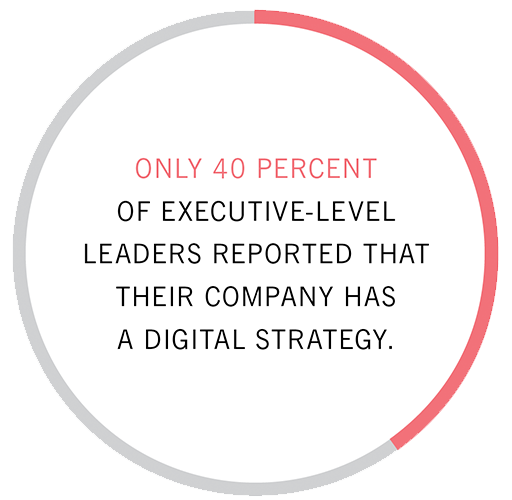How do digital trends create opportunities for companies? With shifts toward innovative, mobile technologies, it is widely agreed that businesses need to embrace the move toward a digital market. But why?
Industries are facing major changes in consumer expectations. Consumers are looking to engage with the marketplace at any time they please at the touch of a button. New digital customers seek integrated, seamless interaction with their chosen vendors. Embracing a digital strategy will enable companies to deliver on consumers’ expectations and interact with their clientele in personal, relevant, and engaging ways.
Many businesses don’t understand the importance of developing a digital strategy. Based on a recent survey by Jabian, only 40 percent of executive-level leaders reported that their company has a digital strategy. In addition, fewer than half of those who reported having a digital strategy said it aligned with the company’s business strategy. Fewer than a quarter of those who said they have a digital strategy said it is always used
to make day-to-day decisions.

When companies don’t have a well-defined digital strategy, a number of issues can arise. They include, but are not limited to, a lack of direction, poor understanding of market share, wasted effort, and inability to optimize on ever-changing trends. Creating a digital strategy can help formalize a plan to address these issues:
Leave competition in the dust
With such a large segment of executive leaders reporting that their company doesn’t have a digital strategy, your organization will gain an edge with expanded platforms to communicate with customers.
Increase control
Formalizing a digital strategy provides a roadmap to traverse the ever-changing technology landscape.
Align strategic priorities
Create a digital strategy based on the company’s business strategy, customer relationship strategy, marketing strategy, IT strategy, mobile strategy, and social strategy. It becomes a fully encompassing how-to guide for all things digital.
When companies envision their evolving customer and market, the value proposition is clear. The average person makes thousands of decisions each day: where to eat, what to wear, even what information to use and trust. Digital strategy enables more opportunities to interact with a customer and answer these questions.
These opportunities could extend beyond just a website or a mobile app to any space that could provide consistent experiences throughout a customer’s journey. Crafting a sound digital strategy enables businesses to be strategic with the spaces where they interact with their customers.
Once the company identifies these spaces, it must create a plan to deliver its strategy through digital interfaces. To create a meaningful digital strategy, the company must first have a well-defined business strategy (including a mission and vision statement) that is well communicated and understood by the digital team.
Next, the company must define its user groups, which are sets of members who share experiences and ideas to use a specific product. Ideally, this process relies on current analytics, if they are available. After defining user groups, the company must define and map the common customer’s journey, which is the full life cycle view of a customer’s interactions with the company’s brand.
Based on this information, the company can define a digital strategy that uses emerging technologies to enhance customer experience. The digital strategy uses a phased approach to roll out prioritized enhancements, while continuing to apply forward thinking to adapt to new technology. When creating a digital strategy, the most important aspect to consider is creating flexibility and agility to capitalize on all digital opportunities.
